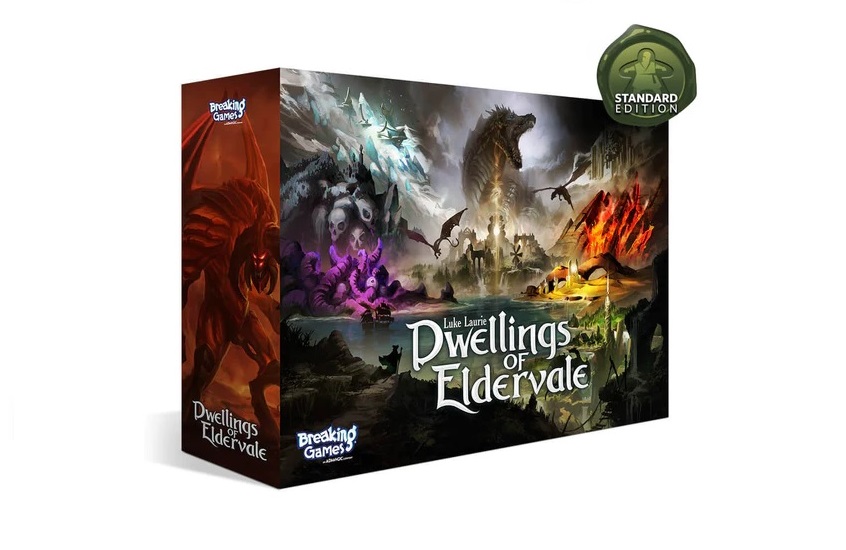
It’s hard to find a good board game in the myriad of modern high-concept content that’s dropping everywhere these days. It seems like everyone that carries anything even remotely geeky carries board games and every store is loaded with a random assortment of what their buyers happened to light upon. It almost seems like there’s no way to tell what’s good or not anymore without just dropping a hundred bucks or so and rolling the dice, so to speak. Into this wild board game wilderness comes the Second Edition of Dwellings of Eldervale from Breaking Games. Originally released in 2020, Dwellings of Eldervale sold out of its initial print run and was hard to get for quite a while. Now that it’s back and available, it’s time to take a look at this game and see why it’s worth your hard earned cash (spoiler alert, it is).
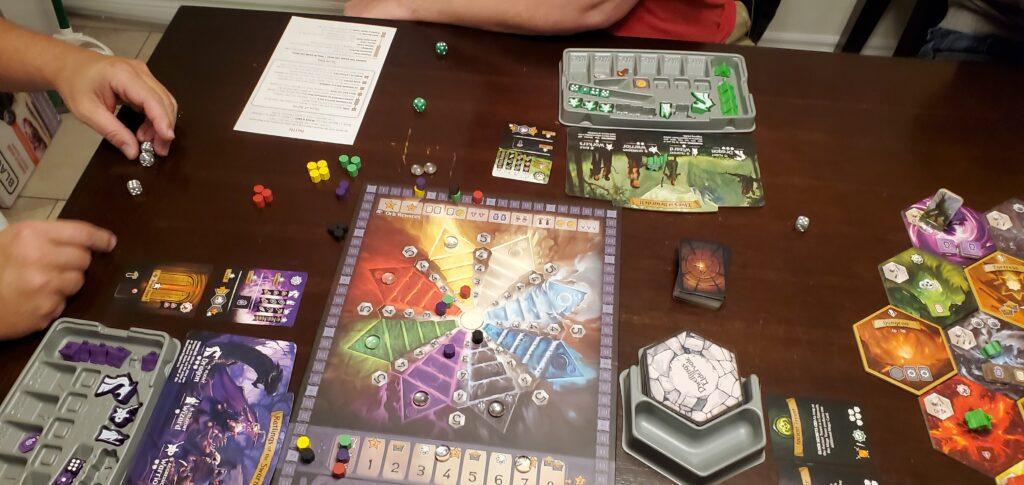
Dwellings of Eldervale is at its heart, a worker placement & victory point game. The initial setup is not particularly difficult, consisting of preset solid wood armies called factions, resources, and an Elemental Scoreboard to follow glory, victory points, and progress up the different Elemental tracks. Your goal is to ‘dwell’ in as many places as possible and earn victory points through a variety of pathways in the game, including completing quests, dwelling, and gaining influence on the Elemental tracks. There are eight Elemental factions for characters available, each with two different groups you can play, leaving a massive variety of special abilities in any given game.
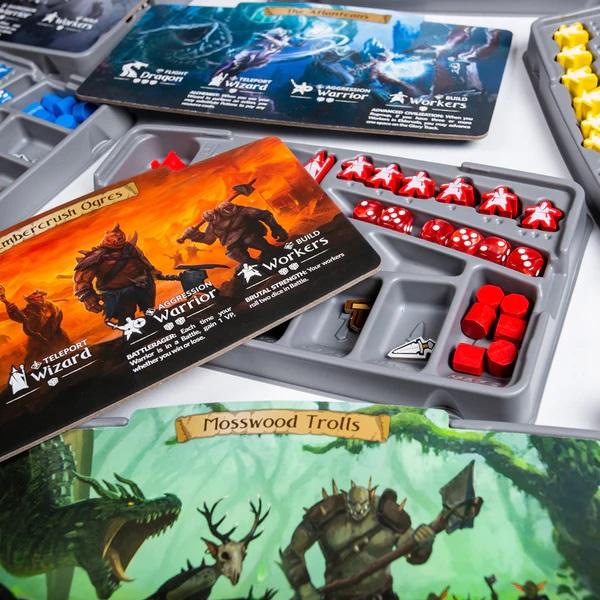
With this variety comes one of the biggest concerns with Dwellings of Eldervale, its initial complexity. While the game isn’t particularly hard, it definitely appears complicated at first glance. There are a lot of pieces, a thick rulebook, and an absolute ton of assorted unfathomable parts that only make sense when you go through the box. The Second Edition also includes figures for The Mother of Dragons and the Frost Giant along with their respective Realms, a welcome inclusion! Upon opening the box, simply punching all the cardboard pieces and sorting and opening everything took the better part of an hour. However, once everything is actually in its place, setup and cleanup are a breeze. Interestingly enough this is a relatively simple game once you get the hang of it even though it comes across as wildly complex.
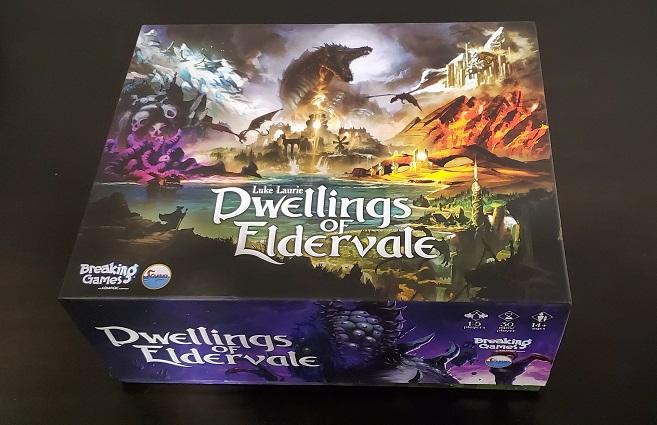
But instead of explaining the rules and the structure right off the bat, I’m going to talk more about how my board game group plays Dwellings of Eldervale. There are two distinct schools of thought on board game structure and gameplay. One insists that the rules of any game are sacrosanct and that we must play the game the way the developers intended when they laid down the original rules and design. The other school of thought is that games are only as good as they play and that if an element of a complex board game doesn’t work, ditch that element or modify it in a way that makes the game more playable. I’ve been playing with the same group for about 20 years and this is how we play. It also doesn’t hurt that some of the guys have made and published their own games before and they have a fairly robust knowledge of board game design.
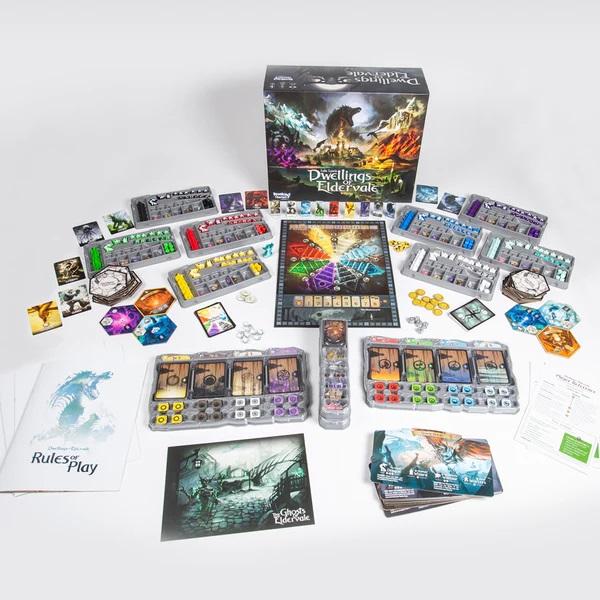
When I started setting up Dwellings of Eldervale, I realized that I had played it once before with my group right around the time the pandemic really got going. As I talked with the group, they reminded me that we’d already dumped all of the optional mechanics and setup to streamline the game and balance out the strategies built into the system. The wicked cool optional Mother of Dragons figure? Out. The optional Frost Giant? Out. Our monsters had their card text axed as well. While it’s cool to have stuff like poison, who wants to track it? Where’s the tracking area of the board? It’s all just a bit too much so we just skipped that part. Eldervale is a fairly detailed game and our group felt that the Mother of Dragons and the Frost Giant both take up a fair amount of and add relatively little overall in terms of gameplay. Monsters are cool and all, but you need to fight the Mother of Dragons over and over again to defeat her, sucking up valuable resources and time while other players are dwelling and the Frost Giant’s bridge changes the way layouts work in a way that’s fairly inconvenient for strategy and planning, especially in a game where you need to be adjacent. If it comes out early, it can really change the dynamics of the game. That’s not to say that these are bad additions to the game, they’re not! They just don’t work well with our group’s relatively aggressive play style. Note that the Standard version of the game does not come with the Oracle Ruin or the Mercenaries expansion so I couldn’t test those portions of the game.
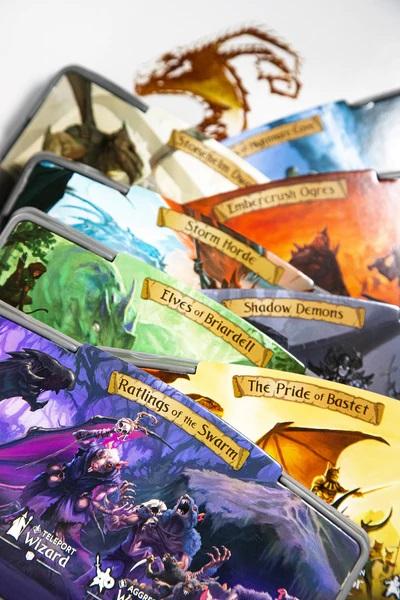
We also dumped starting magic cards, a more substantial modification. The magic cards are inconsistent because the relative power of the cards you can draw in the game is wildly unbalanced, giving some players a spectacular advantage right from the start while others get relatively little benefit and are at a significant disadvantage for no particular reason. Add that to the extra starting points that players get for not being first and so on and you can end up with a rather unpredictable game. On top of all of that, this is a dice-roller as well as a worker placement game. Dice games have an inherent randomness that is only multiplied by the inconsistent power of the cards so we felt that if you chose to play with cards, you’d have to make gameplay sacrifices in order to acquire them, a balance shift that tilts the game more towards on-board strategies and planning. Due to all those factors we felt that the starting magic cards were just a bit too much and if you want to take a magic card route, you’ll have to earn them. Remember, this is our house rule though, and house rules are made up for specific groups! None of this is in the manual!
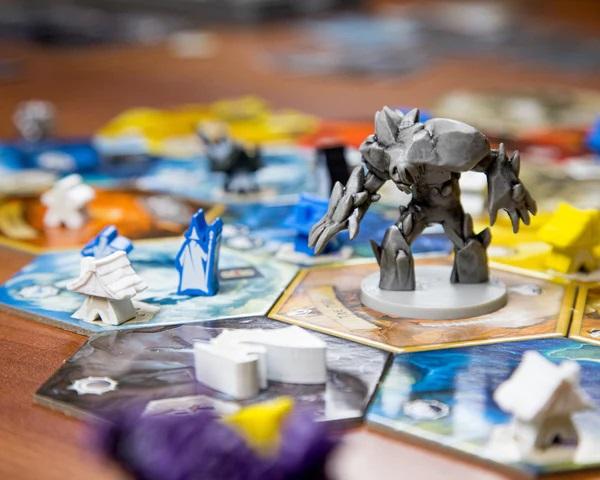
The actual start of Eldervale is not much different. You receive three worker meeples and you place each on a hexagonal starting Realm in turn order to pick up the resources from it. There is no combat the first round so you can place next to monsters which are on the board without fear of being smashed to death by a giant or whatnot. Once each player has finished placing and recalled their workers, things get a little more vicious though.
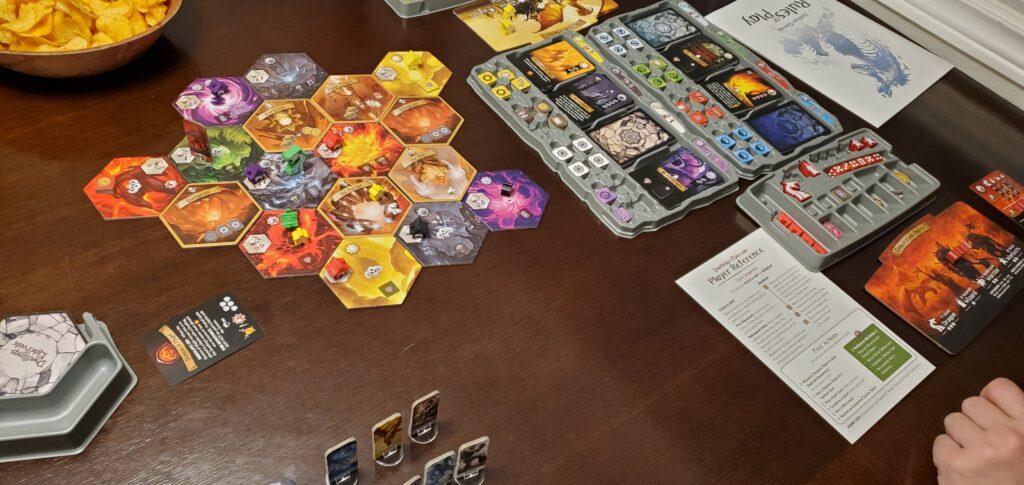
It’s important to plan ahead in Dwellings of Eldervale as you must place adjacent to the first piece you place (excluding the wizard). You have workers, a knight, a wizard, and a dragon that you can utilize once they’ve all been summoned. Summoning consists of placing a recalled meeple on the summon section of your Ready card and paying the associated costs. Knights can be placed in occupied spots with other players’ meeples. Dragons can be placed up to two spaces away from adjoining characters of your color (not on occupied spaces though). Finally, wizards can go to any Realm (aka space) on the board. What’s interesting about Eldervale though is what happens after the placement.
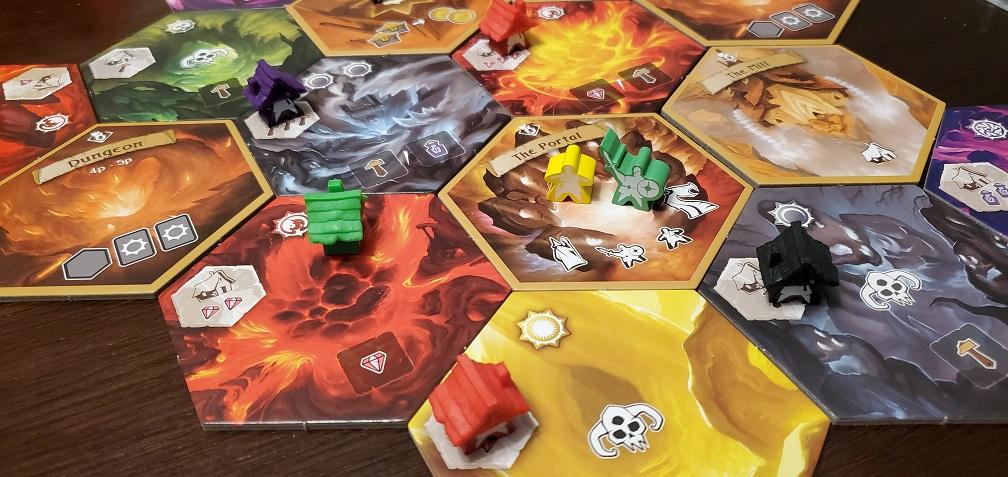
Knights are your primary combat units, triggering fights with others. They get two dice as a base roll in comparison to the one die that workers get. However, once combat is initiated, anyone adjacent can join in, including other players who were not previously involved in the combat. Workers, dragons, and even adjacent dwellings can join in! Once the involved parties are determined, combat commences. The highest die rolls overall win, with all other parties being sent off to the Underworld and a sword token being given to each loser for each character that dies. However, you can also bump your combat power with swords tokens, adding an extra die per token. The winner goes up the glory track on the Elemental Scoreboard and reaps the benefits as well as holding the territory, an essential part of dwelling.
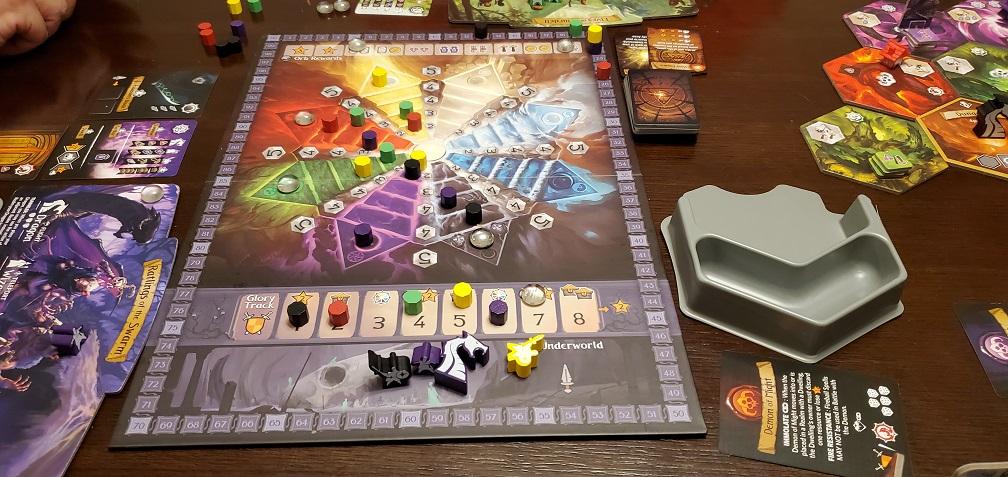
Now, when you place a meeple on a Realm, several things happen. First, you fulfill the obligations of the space. If you cannot do what the space commands and pay the resource costs required, you cannot place there, restricting your placement and making the game more challenging. Placing means you must complete your action, whether that be summoning, dwelling, or gathering resources. Once that happens, the rest of the actions can take place. If that is combat, combat resolves. If you are adjacent to a monster, that monster comes in and attacks you. Monsters are fascinating in Eldervale, partly due to excellent design work and partly because it is always frustrating to go about your business and get trampled by a giant monster.
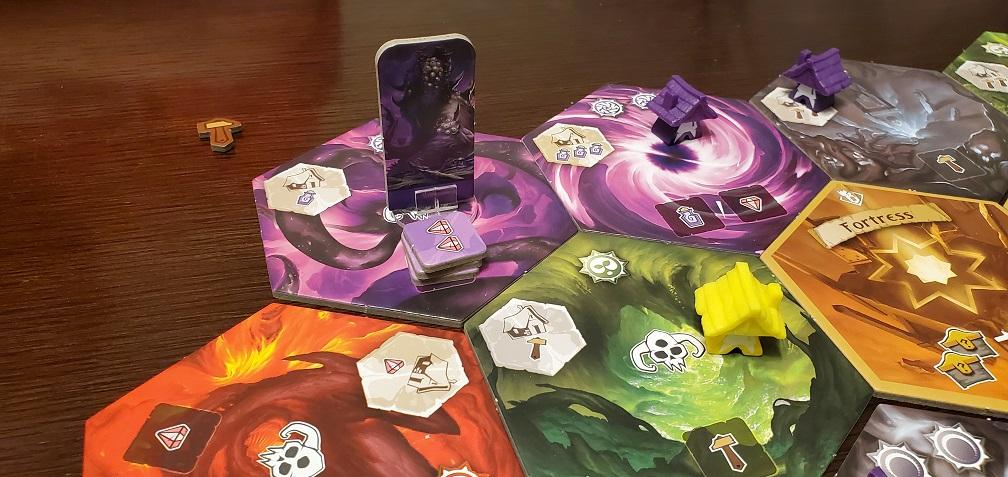
The game includes ten different monsters. In this standard edition, they are full color cardboard standees with little plastic bases. In the deluxe versions of the game they can be plastic figures and even have sound chips to add more depth to gameplay (at an added cost, of course). If you place on a Realm next to a monster because you either need those sweet, sweet resources, want to dwell there, or just like a fight, the monster begins a Monster Rush and comes in on you. Only one monster can be in a Realm at a time, so no worries about getting double-teamed. You also get to choose which monster comes in if there are two monsters adjacent. Unfortunately, they’re pretty powerful, usually with 4-5 dice to roll. The chances of you killing one easily, especially with a single worker are low, so make sure you’ve got adjacent help if you decide to take one on!
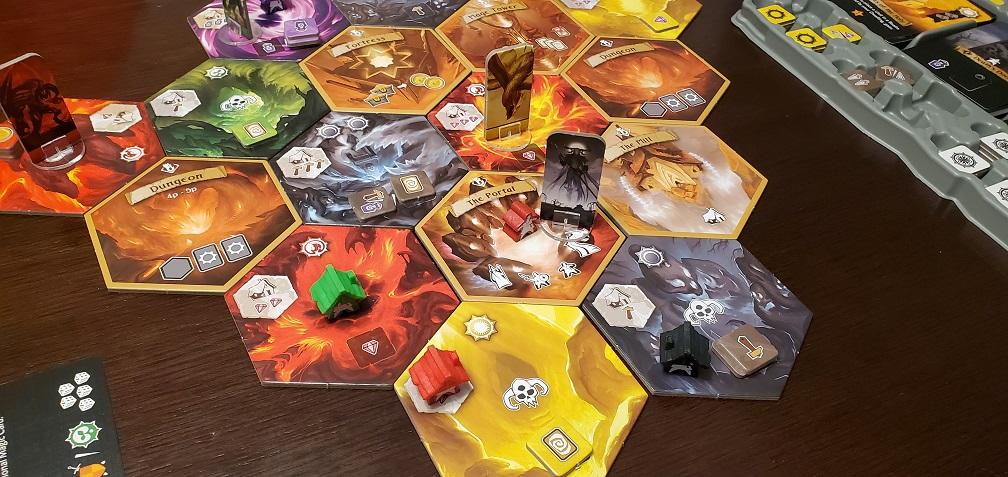
If you look at the cards for the monsters, each has a special ability, some positive, some negative. You might have to discard precious resources to fight them, lose every unit in combat, be blocked from access to reinforcements, gain additional magic cards, or even get victory points. We found that while these abilities are cool, they can also be confusing and really slow the game down a bit, so we streamlined them out and simply fought the monsters with dice. Even that ended up challenging and several times each play, some players lost to monsters badly, losing valuable regrouping time and putting them at a significant disadvantage. Toss on the other monster powers and things get pretty wild!
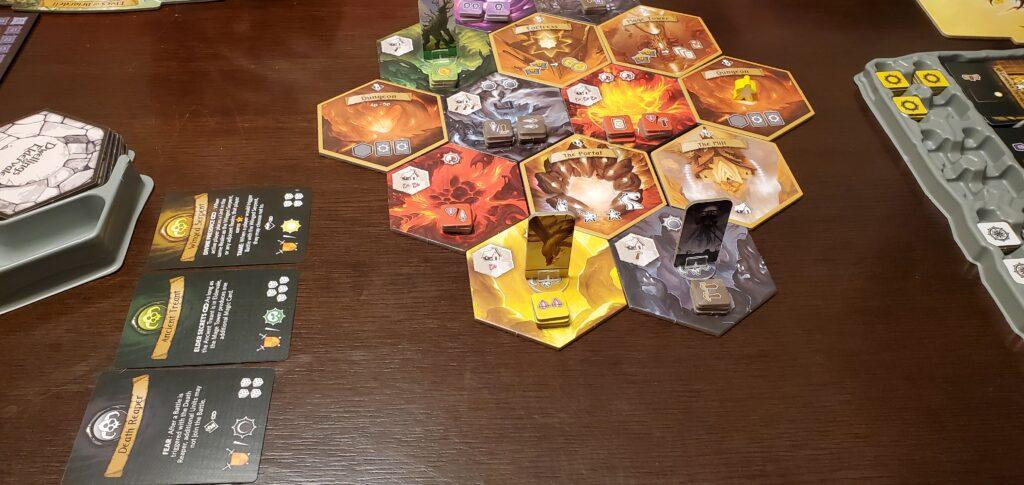
Speaking of regrouping, this is one of the most important parts of Dwellings of Eldervale. Once you have exhausted all your placements and have no more meeples, you must withdraw. Doing so allows you to pull meeples from the Realms and place them in the regroup area. This is where you can summon more meeples (if you have the resources), gain extra resources, or most importantly, dwell. Unfortunately, any meeples who have been killed in combat with monsters or players are in the Underworld (on the Elemental Scoreboard) and cannot gain any regroup benefits. You can also place regrouped meeples on your tableau, giving you massive extra bonuses if you meet the conditions!
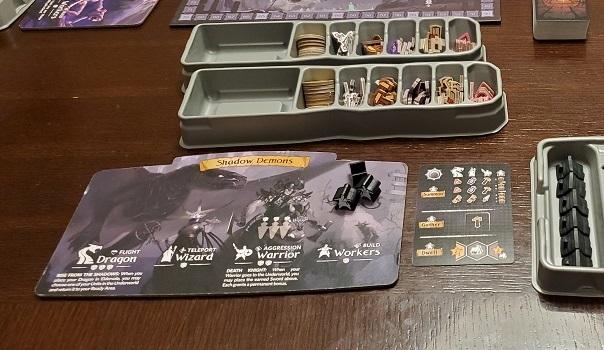
Your tableau is an open area with all of the Adventure cards you’ve purchased. Through the game you can use resources to purchase Adventure cards (if you go to the Dungeon, which you will). Buy an Adventure card and it comes to your tableau, giving you the ability to regroup to it and gain additional resources. You can also slot resource tokens from the Realms into empty spaces on the Adventure cards, granting powerful added regroup bonuses. There are only a limited number of slots for resource tokens in your tray and if you don’t use them for one-time bonuses, they are available to slot onto your cards. Don’t worry, it all sounds more complex than it is and a round or two will have you feeling like you’ve played the game for years!
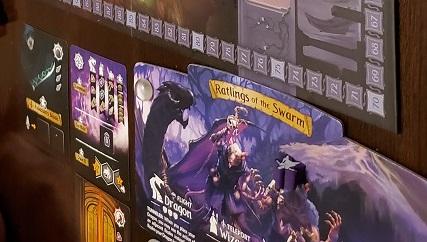
It’s now time to talk about dwelling. Each space has a Dwelling image on it. Dwelling can be done during regrouping (although it takes an extra meeple to dwell). If you have a worker on a Realm with no dwelling on it, you can pay the cost of the dwelling image to dwell there. You pop a roof on that worker’s head and they are now a dwelling! They can no longer move, be regrouped, or placed. However, you gain victory points for each adjoining special space and other dwelling of yours next to them! They also cannot be killed or displaced, giving you permanent combat bonuses in that Realm. Dwell with all six worker meeples and the game is over! Chances are if you’ve managed to do that, you’re probably close to winning as well, but it’s very hard to do. Now, if you start with three workers and dwell, you’ll only have two to place next turn, so you’ll need to regroup and summon more. No resources? You’re in trouble! Planning is everything here! Each summoned worker costs more until you get all six out, so don’t forget or dwelling will be unachievable and the rest of the board will be gone!
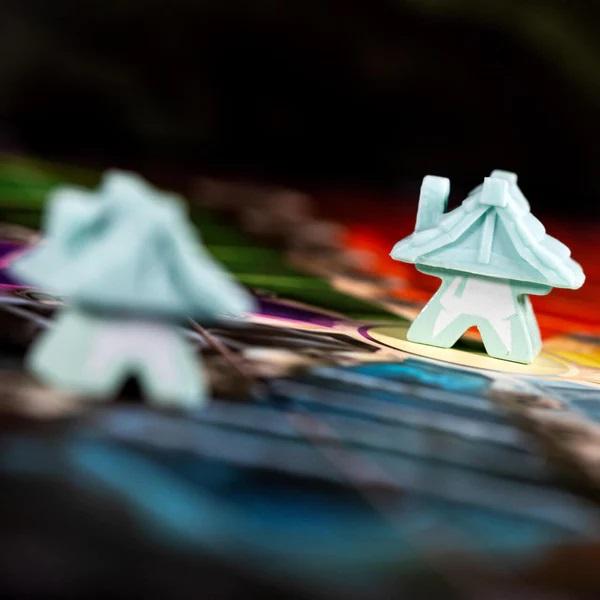
Once either all the Realms are placed or someone has dwelled six times (it’s almost always the Realms for our group), the game ends. You tally up all the elemental points, all the tableau points and all the magic cards that provided end of game bonuses. There’s a lot of adding to do but at this point, you usually have a pretty good idea who won. If this all sounds pretty complex, once you’re familiar with the rules, a decent game with 5 people takes around 45 minutes to complete. It’s not a ridiculously long game and the infighting towards the end when there are only limited options left is enjoyably vicious!
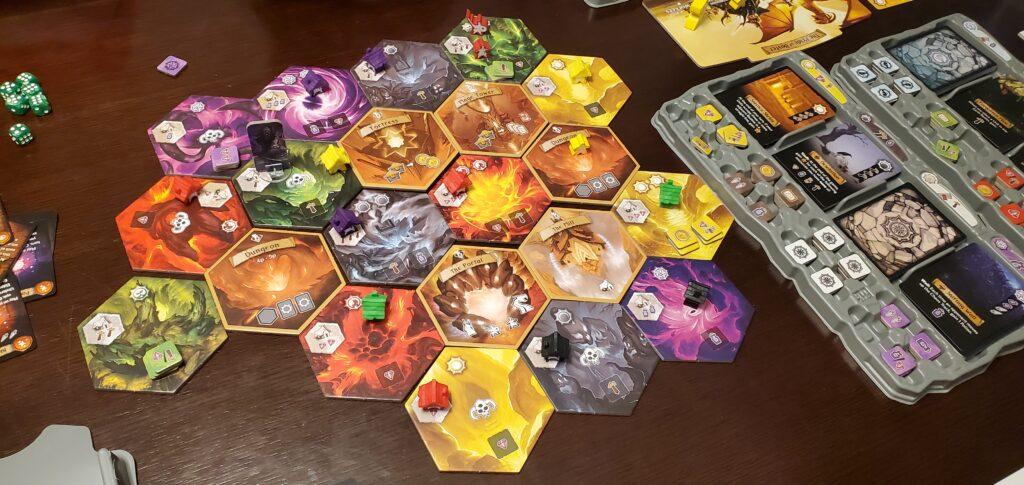
Whew! Tired yet? There’s a lot to say about Dwellings of Eldervale because it’s a great game with a lot of versatility. There’s one more thing to cover too, the single player version of the game! In addition to a game for 2-5 players, there’s a solid single player game included here as well for those times when you really feel like getting your game on but no one is available. This is called The Ghosts of Eldervale and it comes with its own mat, a Watcher meeple, and 24 Ghost cards. You are playing against a team of ghosts who function by specific rules different than those of the main game. For example, ghosts can dwell immediately after entering a space, changing the dynamics of the game, Monster Rushes and so forth. They make preset choices based on die rolls, cards, and the rule set in the manual when there are options while Watcher follows the player passively around the board and affects gameplay by impacting how the ghosts move.
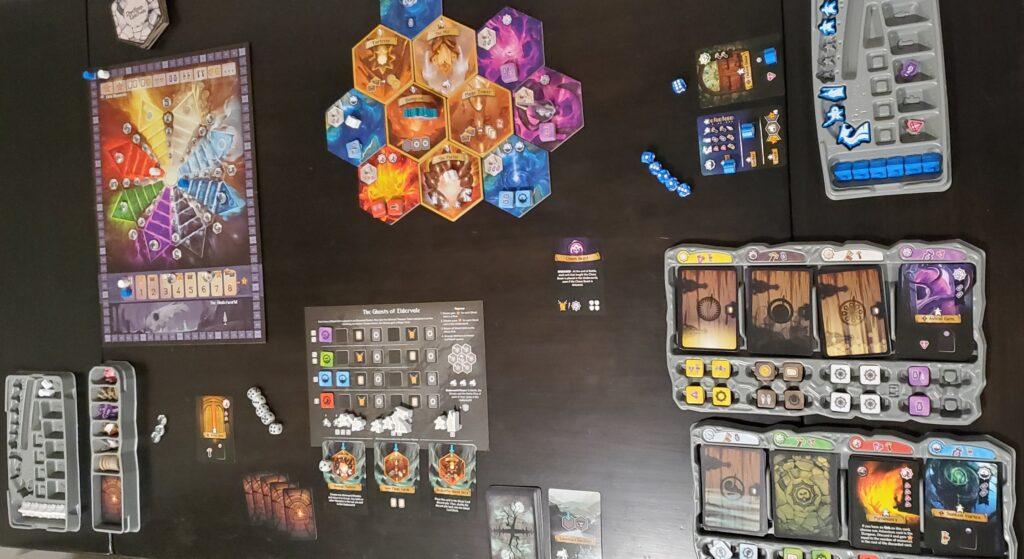
The single player game is surprisingly fun considering you’re playing a board game alone. While multiplayer is naturally more compelling, the way that dice rolling and ghost choices are designed makes you feel like you’re actually playing against another opponent rather than yourself. The guide to play that comes with Ghosts of Eldervale is remarkably well-laid out and you’ll have a solid half-hour to 40 minutes of fun playing it. It was entirely unnecessary for Breaking Games to include this mode, especially since it required an extra board, extra cards, and an extra meeple, but it’s certainly a welcome addition to the main Dwellings of Eldervale game!
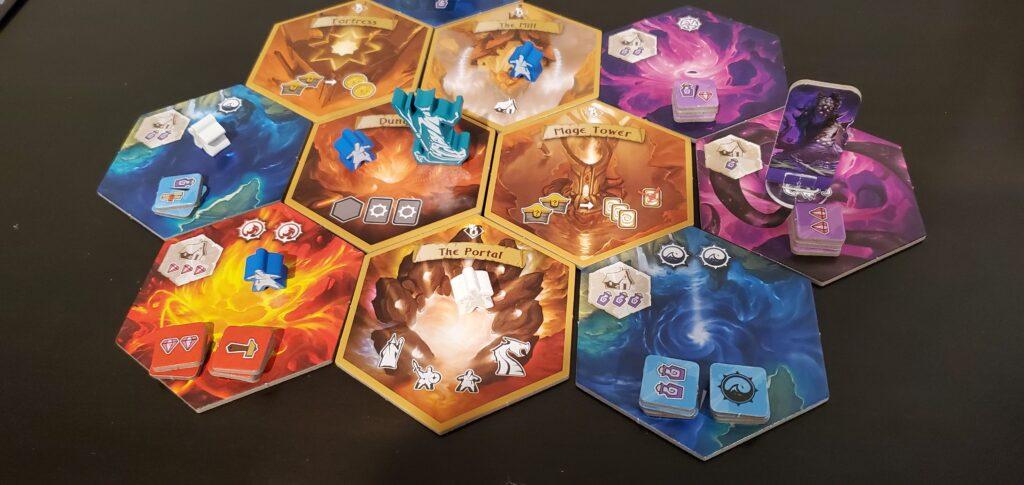
The last thing you’ll want to know about (I promise) is the quality of the game itself. Dwellings of Eldervale comes with a massive box and a ton of plastic game trays. It’s intimidating and wonderful at the same time. Tray design is fantastic and the plastic is quite solid. Each tray has slots for every resource, card and meeple that clearly delineate where they need to go. Once everything is in its place, faction cards slot nicely into the tops and lids lock down onto trays, keeping everything secure even if you turn the box sideways (I tried this). The manual even has a helpful guide to how to stack everything inside of the box and trust me when I say not nearly enough games provide this information. With a game with this many trays, you need a guide just to put it away! Fortunately after a few turns you’ll be an old pro, so don’t sweat it! The wooden meeples are also high quality and the paint jobs and pre-applied decal transfers are excellent. The monster tokens are a bit small on the standard version, but that’s not too bad. Cardboard is thick on all the resource tokens, monsters, and Realms though and the only niggling issue is that punching the tiny resources can tear bits of the images if you don’t punch them carefully. Even the cards are a nice thick card stock and will last forever if you end up buying sleeves too!
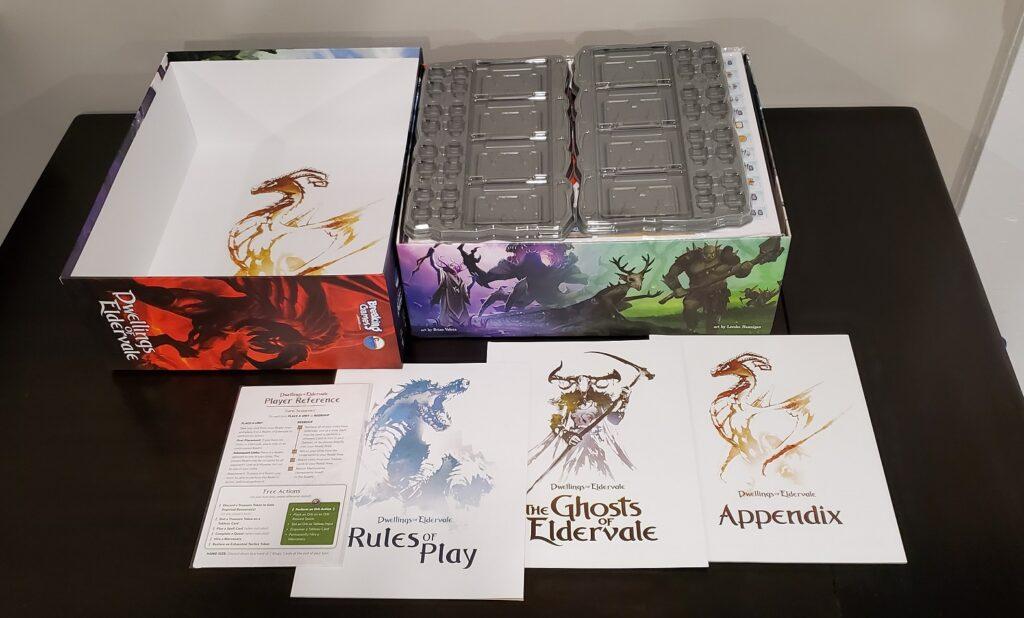
Ultimately, Dwellings of Eldervale is an amazing game that’s going to give you years of play value whether you’ve only got a couple of players or a larger group like ours. Different player setups are balanced mostly the same but five is ideal of course. For $100, you’re spending a bit more than a standard game, but you’re getting a heck of a lot! Breaking Games also offers expansion parts on their website including deluxe monster and resource upgrades and expansions, making a solid release even more impressive. This is a game that is not only worth your time but is well-designed no matter how many players you have or what rules you decide to utilize! The versatility is excellent and the fun factor is high, even when you’re losing rather badly like I did the last time we played! If this is the sort of game that appeals to you, don’t hesitate because you don’t want to miss out on Dwellings of Eldervale!
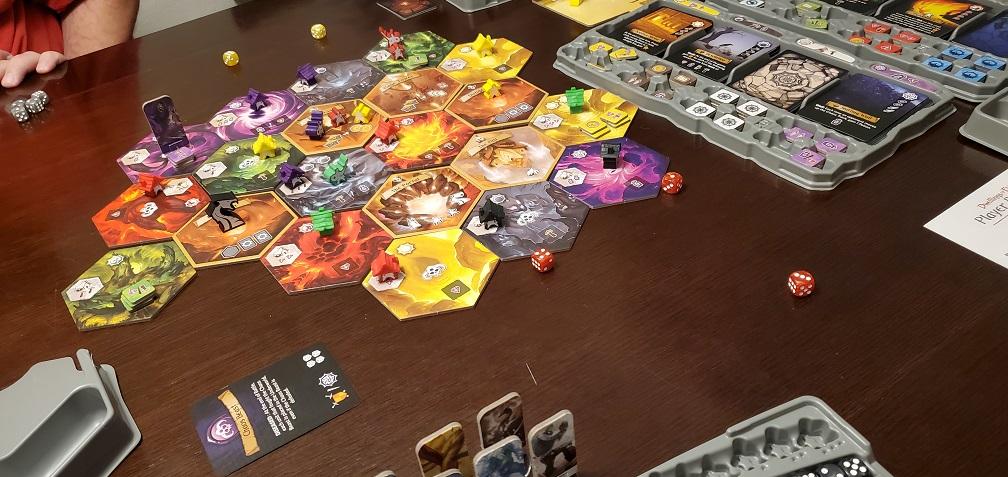
This review is based on a physical copy of Dwellings of Eldervale provided by the publisher. Dwellings of Eldervale is available at fine board game stores online and in physical locations based on their inventory and at breakinggames.com.

